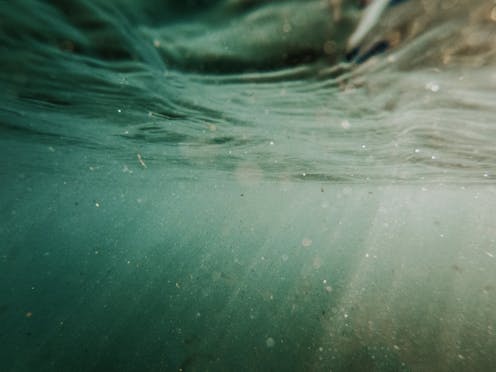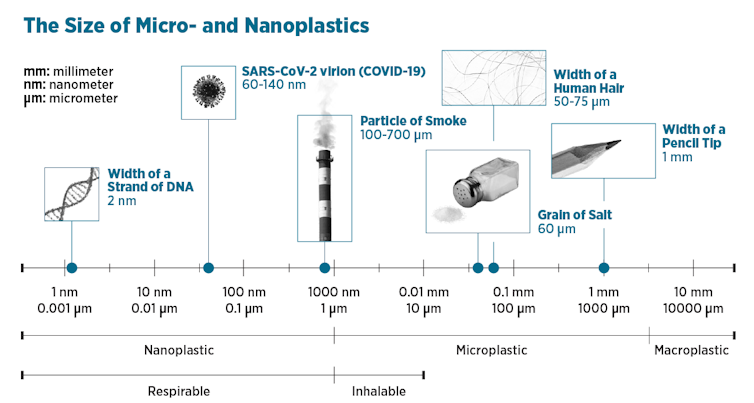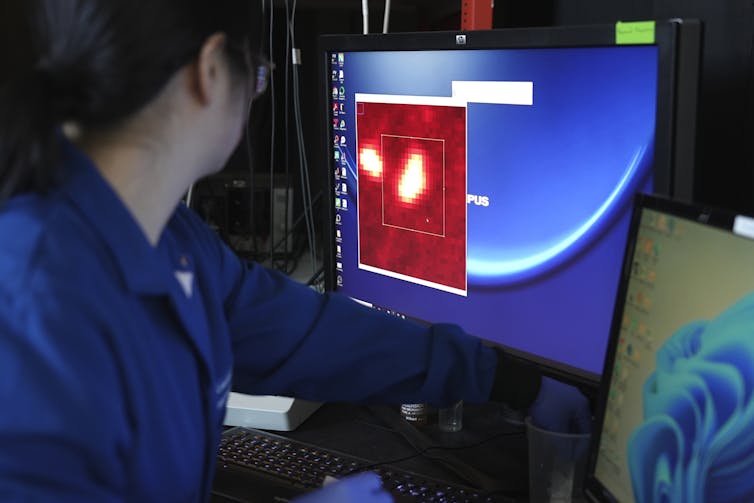What are nanoplastics? An engineer explains concerns about particles too small to see
Nanoplastics are the smallest microplastics, far narrower than a human hair. Very little is known about their composition, structure or how they break down in the environment.

It’s become common to read that microplastics – little bits of plastic, smaller than a pencil eraser – are turning up everywhere and in everything, including the ocean, farmland, food and human bodies. Now a new term is gaining attention: nanoplastics. These particles are even tinier than microplastics – so small that they’re invisible to the naked eye.
Nanoplastics are a type of microplastic, distinguished by their extremely small size. Microplastics are usually less than 5 millimeters across; nanoplastics are between 1 and 1,000 nanometers across. For comparison, an average human hair is roughly 80,000-100,000 nanometers wide.
Nanoplastics are attracting growing concern thanks to recent technological advances that have made researchers more able to detect and analyze them. Their smaller size means that they are more easily transported over long distances and into more diverse environments than microplastics. They can more easily penetrate cells and tissues in living organisms, which could lead to different and more acute toxicological effects.
Studies in the past two years have found nanoplastics in human blood, in liver and lung cells, and in reproductive tissues such as the placenta and the testes. Around the world, nanoplastics have been found in the air, in seawater, in snow and in soil.
We already know that microplastics are present from the heights of Mount Everest to deep ocean trenches. Now there is growing evidence that nanoplastics are more prevalent than larger microplastics in the environment.
Where they come from and where they go
Nanoplastics are created when everyday products such as clothes, food and beverage packaging, home furnishings, plastic bags, toys and toiletries degrade. This can be caused by environmental factors such as sunlight or wear and tear from mechanical action. Many personal care products, such as scrubs and shampoos, can also release nanoplastics.
Like larger plastic particles, nanoplastics can come from a variety of polymer types, including polyethylene, polypropylene, polystyrene and polyvinyl chloride. Because plastic products are widely used, it is hard to avoid nanoplastics in our daily lives.
When plastics reach the nanoscale, they present unique questions and challenges because of their tiny size and varying surface properties and composition. Since nanoplastics are small, they can easily penetrate cells and tissues that larger particles cannot. If they accumulate within living organisms, they could potentially cause adverse biological effects.

The fate of nanoplastics in the environment is an ongoing research topic. Scientists don’t know yet whether nanoplastics further degrade in various environments into smaller particles, or into polymers, which are their basic building blocks – large molecules made of many small molecules strung together.
Detecting nanoplastics
Finding nanoplastics is challenging because they are so tiny and have diverse chemical compositions and structures. Researchers are refining different approaches for detecting nanoplastics, using techniques including Raman spectroscopy, chromatography and mass spectrometry. These methods can see the shapes and analyze the properties of nanoplastic particles.
In a 2024 study, researchers from Columbia University presented a new technology that was able to see and count nanoplastics in bottled water with high sensitivity and specificity. Unlike previous studies that could detect only a limited amount of nanoplastic particles, this study found that each liter of bottled water that was analyzed contained more than 100,000 plastic particles, most of which were nanoplastics.

More studies need to be done before scientists can conclude whether all bottled water contains nanoplastics. But this new technique opens the door for further research.
Are nanoplastic particles toxic?
The toxicity of nanoplastics is another field of ongoing research. Some studies have suggested that these particles could pose significant risks to ecosystems and human health. One recent study suggested that they may be a risk factor for heart disease.
Another concern is that chemical pollutants, heavy metals and pathogens may stick to nanoplastics and become concentrated in the environment. This process could potentially expose living organisms to high concentrations of these harmful substances.
Nanoplastics clearly are a part of modern environments, but scientists need more research and information to understand what kinds of threats they could pose. As toxicologists often say, “The dose makes the poison.” In other words, actual exposure matters a lot. It is difficult to assess toxicity without knowing actual concentrations.
It is well known that larger plastic debris can fragment into nanoplastics, but there is much to learn about how these fragments degrade further. Researchers are working to detect and understand nanoplastics across many environments so that they can develop effective strategies to manage and mitigate these materials’ effects on people and the planet.
Mohan Qin receives funding from Wisconsin Sea Grant.
Read These Next
What is pasteurization? A dairy expert explains how it protects against foodborne illness, including
Before World War II, pathogens in milk accounted for 1 in 4 cases of foodborne diseases in the US. Pasteurization…
History says tariffs rarely work, but Biden’s 100% tariffs on Chinese EVs could defy the trend
The early timing of Biden’s move, changing supply chains and national security fears suggest the tariffs…
Modi’s anti-Muslim rhetoric taps into Hindu replacement fears that trace back to colonial India
The Indian prime minister made reference to communities that have “too many children” in a veiled…




